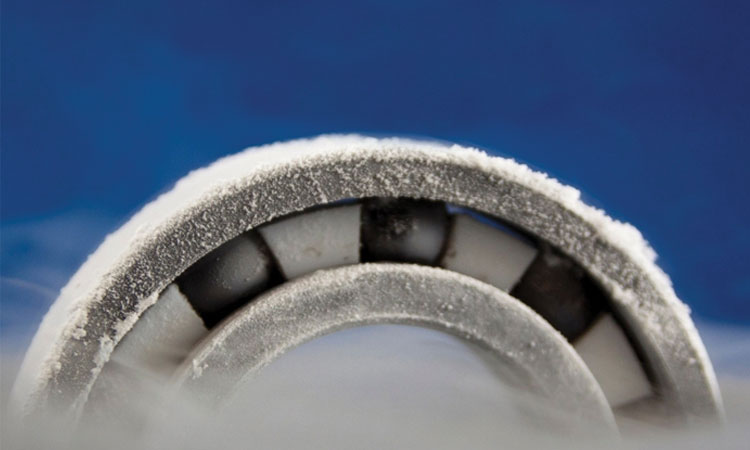Cryogenic bearings are specialized bearings designed to operate effectively at extremely low temperatures, often in cryogenic environments where temperatures can be as low as -150°C (-238°F) or even colder. These bearings are engineered to withstand not only the extreme cold but also unique challenges such as brittle material behavior, lubricant freezing, and high thermal contraction rates.
Key Features of Cryogenic Bearings
Material Selection: Cryogenic bearings are made from materials that maintain their structural integrity and toughness at low temperatures. Common materials include stainless steel, titanium alloys, ceramics, and sometimes advanced polymers. The choice of material depends on the specific cryogenic application requirements, with a focus on resistance to thermal contraction and brittleness.
Lubrication Challenges: Traditional lubricants, such as oils and greases, can freeze at cryogenic temperatures, leading to increased friction or complete bearing failure. Therefore, cryogenic bearings often use solid lubricants, such as molybdenum disulfide (MoS₂), or advanced, low-temperature lubricants that remain effective even in extreme cold. Some applications may rely on the cryogenic medium itself, such as liquid helium or liquid nitrogen, as a cooling and lubricating agent.
Thermal Expansion & Contraction: Materials can expand and contract significantly with temperature changes. Cryogenic bearings are designed to handle these temperature-induced stresses, preventing misalignment and ensuring smooth operation even as the materials undergo dimensional changes.
Specialized Coatings: Some cryogenic bearings use coatings such as Teflon or diamond-like carbon (DLC), which provide additional protection against wear, reduce friction, and prevent materials from sticking, which is more likely at low temperatures.
Applications of Cryogenic Bearings
Cryogenic bearings are essential in industries and applications where temperatures are far below freezing, as they help maintain reliable performance under these extreme conditions. Key applications include:
Space and Aerospace: Cryogenic bearings are vital in spacecraft and satellites, where temperatures can drop drastically. They are used in rocket propulsion systems, cryogenic fuel storage, and mechanisms for scientific instruments in space missions.
Medical and Scientific Research: In cryogenics laboratories, cryogenic bearings are essential for cryogenic refrigeration systems, MRI machines, and particle accelerators. They help in applications where liquid nitrogen or helium is used for cooling and require precision at low temperatures.
Liquefied Natural Gas (LNG) Processing: LNG production and transport require equipment that operates at cryogenic temperatures to keep natural gas in a liquid state for easier transportation. Bearings in compressors, pumps, and expanders for LNG systems are designed to function smoothly at these temperatures.
Superconducting Equipment: In applications such as magnetic resonance imaging (MRI) machines, superconducting magnets need to be kept at cryogenic temperatures. Bearings used in cooling systems for these magnets help maintain the necessary low temperatures.
Types of Cryogenic Bearings
- Ceramic Bearings: Ceramic materials like silicon nitride and zirconia are commonly used because of their low thermal expansion, high hardness, and resistance to low-temperature brittleness. These bearings are ideal for high-speed, high-precision applications and are often used in aerospace and cryogenic pump systems.
- Magnetic Bearings: Magnetic bearings are sometimes used in cryogenic applications because they operate without physical contact, which eliminates the need for lubrication and reduces friction. They are especially valuable in systems where the presence of conventional lubricants is not feasible.
- Hybrid Bearings: These bearings combine steel rings with ceramic balls, combining the toughness of steel with the low thermal expansion and wear resistance of ceramics. Hybrid bearings offer durability and can be used in various cryogenic applications, including compressors and vacuum pumps.
Advantages of Cryogenic Bearings
- Reduced Friction: Cryogenic bearings are optimized to minimize friction even in low-temperature environments, which is crucial for efficiency and longevity.
- High Load-Bearing Capacity: They are designed to withstand the mechanical loads encountered in extreme applications without compromising reliability.
- Enhanced Lifespan: By using materials and designs suited for low temperatures, cryogenic bearings have a longer lifespan than standard bearings under similar conditions.
- Minimal Maintenance: Many cryogenic bearings are designed for low-maintenance or even maintenance-free operation due to their use of solid lubricants or lubrication-free designs.
Design and Maintenance Considerations
- Thermal Insulation: Ensuring minimal heat transfer in and around cryogenic bearings is crucial for preventing unwanted temperature increases.
- Lubricant Compatibility: If lubricants are used, they must be compatible with the cryogenic medium and not freeze or degrade at low temperatures.
- Precision Alignment: Since cryogenic temperatures can alter the shape of materials, alignment is critical to prevent misfit or wear.
Conclusion
Cryogenic bearings are highly specialized components, engineered to perform reliably at extremely low temperatures where traditional bearings would fail. They serve as a critical technology in industries like aerospace, medical research, and LNG processing, where precision and durability are vital. By using advanced materials, solid lubrication, and unique design features, cryogenic bearings ensure optimal performance in environments that are as unforgiving as they are essential.


